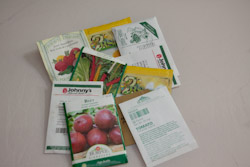Many of us are intimidated by the seed packet display in the nursery, and we choose to purchase the seedling plants already prepared for us by growers. If you have not tried to grow vegetables from seed before, you will find that it is not only easy to do, but economical, fun, and extremely rewarding. Another benefit is the wide selection of varieties available from seed catalogs. Growing different varieties is important for an extended harvest and to find plants that grow well in your area. Vegetable plants sold in seedling form are generally available in only one or a few varieties.
Growing vegetables from seed is generally very easy to do, but takes more time and patience than buying young plants from the nursery. Seeds can be sown directly into the garden soil at the correct planting time for the crop (direct seeding), or they can be grown indoors for several weeks to create a strong young plant that is later transplanted to the garden. Good sources of mail-order seeds can be found at the
UCCE Vegetable Research and Information Center.
For direct seeding, follow the recommendations for spacing between and within rows given by the seed company or at
The California Gardening website or at
The Vegetable Research and Information Center. Direct seeding in early spring can be complicated by rains that soak the soil and make it unworkable, so covering the soil during earlier dry periods with plastic sheeting will keep the soil dry and workable.
Seeding depth is generally never more than 2 – 3 times the seed diameter, and often shallower is better. When direct seeding, plant extra seed and then thin to the recommended spacing within the row.
Seed can also be started indoors, or in an outdoor hot box or cold frame. Warmth and light can be provided by a sunny window, an electric light combined with a germination heating mat, or a plastic or glass covered hot box. Seeds should be grown in a seeding mix, either commercially or home made. An inexpensive home mix is made from 1:1 peat moss: perlite. Never use soil, which can contain pathogens and weeds. Containers can be six-packs, small pots, food containers and drinking cups (make drainage holes), or other specialty products. If containers are new, use them directly, however if they have been used before you should sterilize them by soaking in 9:1 water:bleach solution. Once the containers are prepared, add mix and leach with water thoroughly to remove any salts. Add seeds to the proper depth and water from below. Cover pots with glass or clear plastic to keep in moisture and warmth. Seeding mix is generally low in nutrients so you must supply a light application of complete fertilizer once your seedlings emerge. After germination, increase lighting to prevent etiolation (tall, spindly plants).


